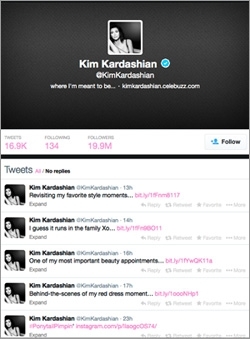
Thirsty for consumer influence, it’s easy to impress marketers with big social-media stats. And, who wouldn’t want a little help from that fellow with millions of Twitter followers,
countless Facebook “friends,” and a huge following on some other network they only recently learned existed.
Yet, according to Dmitri Williams, professor of communications at
USC and a 15-year veteran of analytics and consumer behavior research, brands should be paying more attention to consumers’ closest and most influential connections -- or “social
whales” -- and their "social value." Williams and his colleagues estimate they are responsible for between 10% and 40% of consumer spending.
Social
Media & Marketing Daily: What is “social value,” and what does it mean for marketers trying to get the most out of social media?
Williams:
“Social value” represents a specific amount of spending or actions caused by a person’s influence on their social connections. Any action, interaction or transaction you can think of
can be tracked and a social value determined. Traditionally, marketers have tried to understand who their most valuable consumers were, but looked at them in isolation. Now they need to be looking at
social value, and the most valuable consumers here are “social whales.” … This is not about influencers via Twitter posting. It's about actual behaviors.
SMMD: How exactly is the “social value” of a “social whale” measured?
Williams: We first build a social graph showing who
is connected to whom. Then we look at the actions of those people over time. What we can see is that some people's actions ripple out through their networks more than others. Let's take the definition
of social value. It refers to the influence consumers have on their social connections. Therefore, if a consumer purchases something, the chances of one of his/her friends doing the same goes up. This
kind of influence can be predicted and measured, and if it leads to dollars, it is a value that can be captured and impacted. We find that social value is responsible for between 10% and 40% of
spending.
SMMD: Do marketers put too much stock in social media “influencers,” when defined by social stats alone?
Williams: Absolutely … Unlike Twitter-based scoring systems, we’re not looking to find celebrities with oodles of followers. Everyday social influencers with one, two
or 200 friends make an impact. Sometimes, these are formal group leaders, but most often, they are simply regular people with charisma and a positive effect on others. Often, your best whales are just
the one friend of a group of two to four others who acts as a leader or driving force. The trick will be making sure the people contributing the most to a brand’s community are properly
recognized, rewarded, and provided with opportunities to evangelize. It's key to reward and empower the biggest fans and subsequently drive organic user acquisition and sustainable revenue.
SMMD: In their defense, the best “influencers” can reach a lot of consumers with their messages. Without their help, how can brands scale their social
strategies?
Williams: We’re all social creatures, and we can’t help but affect others and be affected by them -- more profoundly than, say, a celebrity
recommendation. Your friend buys a new song and your odds of buying that song go up. You play a game, and your friends are more likely to. With the science of micro social analytics and machine
learning, we are constantly looking at the “social graph” of each consumer and how they have a ripple effect on their circle of influence.
SMMD: If a
brand wants to maximize “social value,” what platforms and technology vendors should it be investing in?
Williams: The brand needs data at three steps:
acquisition, analytics while in the service and CRM. Acquisition metrics are all about where the users came from. Combine a basic attribution package with insight into the consumer's eventual value
and you can see what your costs of customer acquisition are. Add social value and you get the full picture. Analytics during the life cycle are equally important, and that's where we live. Companies
need to be able to tie social value to specific content and services they offer. Does it go up at level 5, or when they put items in the cart? You have to have these basic nuts and bolts, often beyond
aggregate systems like Google Analytics or Flurry. Then, you need tools to actually reach these social whales. Every firm needs a good campaign management tool and vendors for push notification,
in-app messaging or email--whatever flavor fits the product best.
SMMD: With respect to “social value,” what best practices should brands
be following?
Williams: Brands should first start thinking about how customers relate to each other, not just the brand. Can they impact that relationship by helping
it out? If they make two consumers happy together, the brand will make its money just fine. Sometimes, it's just about giving a discount and seeing that value ripple out, but sometimes, it's about
that more organic social relationship between customers. If the brand recognizes this, they'll realize that they need to piggyback on these influencers. Make them happy and results will follow. Get
more of them because they're worth more than a life time value (LTV) system realizes. And retain them because when they go, you lose more than you thought.
SMMD: For
all their limitations, do you foresee social influencers losing their appeal among brands any time soon?
Williams: Social influencers in the current sense of social
media mavens are still useful. These are the people who make good spokespersons and command attention. I don't recommend ignoring them. What I do recommend is realizing that your spouse, your
co-worker and your friend down the block often command more influence than Ellen. If all you are doing is hiring bloggers, mavens and celebrities, you're missing out on the everyday very influential
things that happen on the local level. It's time to realize that influence is micro, can be measured, and should be leveraged.